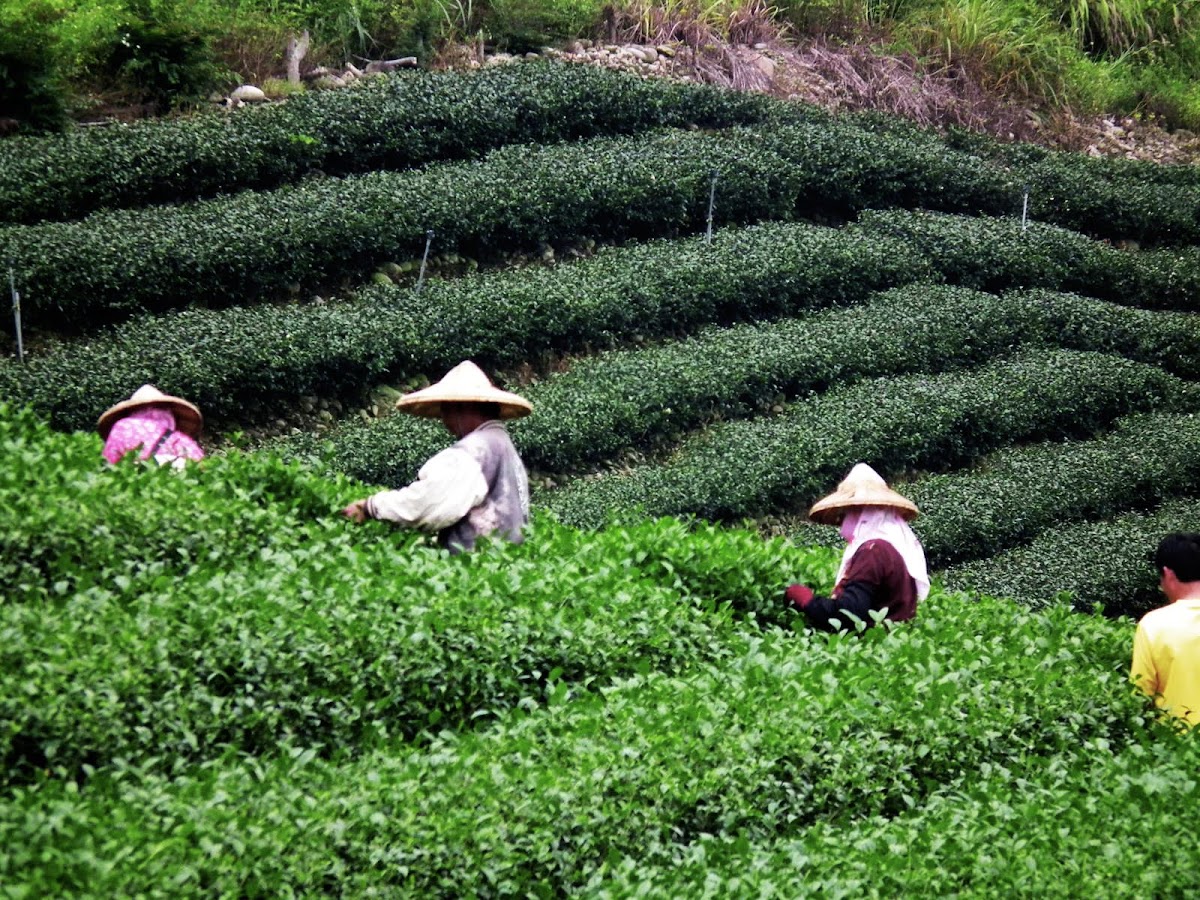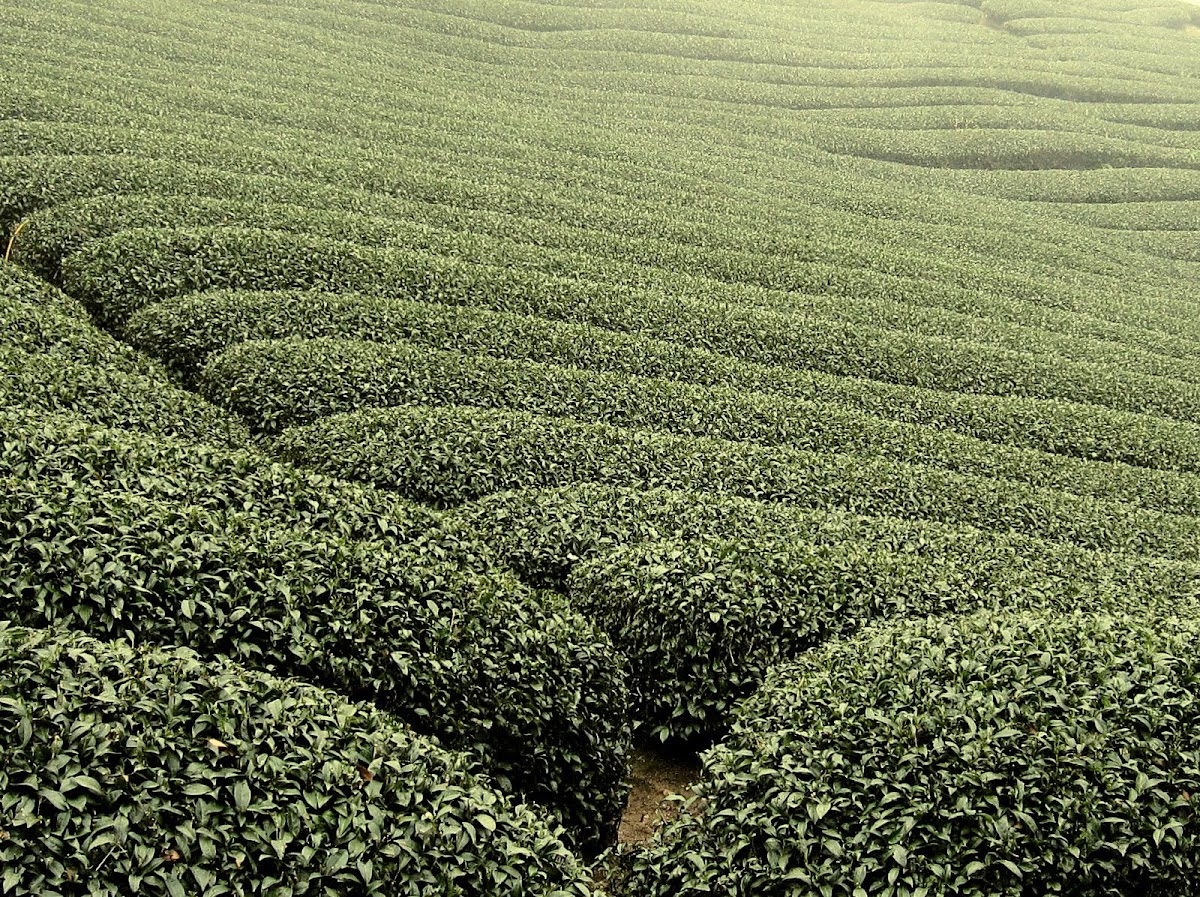
Tea Farmer Friends
Yesterday, The Hungry Cyclist posted a photo and ran a short story on Taiwanese teas and his experience cycling through the northern tea hub of Ping Lin in 2009.
His post aptly explains:
Cutting through the steep hillsides and verdant tea plantations of PingLin is hot, hard work. The undulating coutryside and searing heat make for challenging cycling but also ensure that PingLin grows some of the best tea in the world.
Taiwan is one of the world's leading producers of high quality Oolong teas as well as other varieties. Beyond offering simply the leaves for a hot beverage, Taiwan's tea districts make up some of the nation's best cycling routes.
Many tea growing areas offer occasional food and lodging that can make light touring a real possibility all around Taiwan. Furthermore, the best tea growing areas are high in the foothills and mountains of central Taiwan, which provide spectacular views along roads that are maintained fairly well.
Despite the assumption that tea has been a long and traditional part of local culture, tea cultivation and consumption are relatively new to Taiwanese culture.
Tea drinking culture in Taiwan has really only arisen within living memory as most Taiwanese were traditionally too poor to afford tea. The ubiquitous tea set and table that occupies so many Taiwanese living rooms is more a recent expression of wealth and status than a long held tradition.
Tea production in Taiwan really only started to develop during the final decades of Qing imperial rule and was more directly related to Taiwan's place in the 19th Century global marketplace as an agrarian center.
Between 1860 and 1895 the American demand for Oolong teas provided the spark that led to the expansion of Taiwanese tea cultivation into a multi-billion dollar a year industry.
By the 1860's large swaths and pockets of Taiwan's western plain had been opened for cultivation and the local plains dwelling austronesian indigenous peoples had been incorporated into the Qing administrative structure. Even the sub groups of indigenes who had withdrawn into the foothills had relented and come under some form of Qing governance. Hoklo and Hakka speaking immigrant farmers from Fujian had established a strong economic culture on the plains an Hoklo became the dominant language of the marketplace. Still, most of Taiwan remained "beyond the pale" and ungoverned by the Qing imperial state. Highland indigenous peoples still resided outside the reach of a foreign government.
During this period Taiwan's political economy was also greatly influenced by the geopolitical projects of European and American colonial interests. The Opium wars and their indemnities expanded foreign influence over the regional economy as Taiwan's agricultural production shifted from sustenance farming to feeding the voracious appetite of the West. The value of tea exports rapidly grew from 9.4% in 1864 to 58.4% in 1891.
The tea boom at the end of the 19th century turned the tiny tea plant into a virtual money machine for minting what was termed "green gold". Many Hakkas and lowland indigenes or ex-Aborigines used their experience as dry farmers (as opposed to wet rice farming), as well as their locations in the foothills, to transform their land into centers of tea cultivation. Much of the farming was done by tenant farmers who were required to cultivate the land and pay tax on the tea bushes. The taxation of production was perceived to be more fair than the head tax paid by some indigenous peoples and may have led to a gradual change of ethnic identity in the mountain regions.
I am not only a cyclist, but I am also a tea lover. I have been drinking tea since I was 10 years old, drinking Red Rose black teas... until I scalded myself after grabbing a superheated mug out of the microwave, which resulted in a scar that stuck with me for 3 years.
I have been interested in Taiwanese teas for over 15 years, when I would sit around drinking tea with my Taiwanese language exchange buddies in college. Ever since then I have been developing my palette for tea.
As I cyclist it is even more exciting to go off on some mountain climb to see the fields where some of your tea was actually grown and picked.
Many of the teas I sample and source end up at Miro Tea in Seattle, so if you are lucky enough to visit, Miro will have some excellent Taiwanese tea.
One of my favorite rides is through the tea district of Lugu. I have ridden this area numerous times and I am always impressed by the scenery and the quality of many of the local teas.
This past weekend, the day before my bike broke, we took a non-cycling trip up there again to visit some friends.
My friend and supplier of some excellent Dong-ding Oolongs, Jacky, was on hand to receive his award for the best tea in the Lugu Tea Farmers Association Winter Tea Contest.
The contest took 21 samples from over 5000 farmers and subjected them to repeated, anonymous testing. This ensures greater fairness in the competition, which costs each farmer NT6000 to enter and is extremely labor intensive.
Other contests in Taiwan are subject to manipulation by speculators in organized crime who buy up the winning tea before it is judged and then sell it for the inflated price.
Jacky was able to sell his 21 jin (600g) to a collector for NT2.2 million.
We have visited Jacky's farm and hostel on several bike trips to Lugu, and Jacky is also the one who rescued me when I could not fix my tire high up on the Highway 16. We also bought some of his winning tea before Jacky was awarded the title of "King of Teas".
Aside from congratulating our friend, we also used the opportunity to test different teas and network with other farmers who were on hand to hawk their teas. For many farmers their chief concern was the dilution of Taiwanese teas with inferior and potentially tainted Chinese and Vietnamese varieties.
The demand for Taiwanese teas far outstrips the supply, so many wholesalers are mixing their teas. Although Taiwan has very strict standards to limit pesticides and pollution levels in the teas, Chinese and Vietnamese growers are not subject to the same restrictions.
The recent lowering of tariffs on Chinese agricultural products has made this practice even more of a threat to Taiwanese farmers.
For regular tea drinkers it is best to buy directly from a trusted farmer rather than a wholesaler. I am happy to have built some great relationships with local farmers and even biked out to check their fields.
I am glad I am not on the other end of that
If you are going to ride up to Lugu, I highly recommend taking the 131 to the 151. It is a nicer and quieter road. From there you can take several smaller roads all over the mountains.
On this particular trip we were interested in checking out some hong-pei, or charcoal roasted tea. We saw one farmer on the side of the road doing a roast.
He was roasting the tea under burning rice husks.
I love Taiwanese hospitality.
This farmer not only answered our questions, but also took us on a full tour of his facility and an impromptu tasting of a batch he had finished that morning.
We had to leave with some freshly roasted tea leaves. They need to sit a while, but they wee very good.



Mr. Liu and I

Subtropical Oolong from Songboling
One wonderful ride I would love to do, is a tour of Taiwan's tea country.
Tea country actually starts on the southern side of Alishan, where some farmers around meinong produce Oriental Beauty tea, which is oxidized as it is digested by the larvae of the Tea Green Leafhopper insect. The digestive juices of the Leafhopper give the tea a distinct sweetness. It also ensures the tea is free of pesticides.
A trip up the Highway 20 to connect with the 159甲 over Alishan past the Gaoshan tea farms. Since Typhoon Morikot gave the government a pretext to relocate indigenous peoples from their traditional lands, many tea farmers are pushing for those areas to be opened up for tea farming.
The 149 to Shuili goes right past the Taiho farms. Then a trip up the 14 to the top of Hehuan Shan to get to the back side of Lishan, where some of the best Gaoshan teas are grown.
The Highway 7 gos from Lishan out to Taiping Shan and Iilan, where I like to buy some balanced Baozhong teas. Pinglin, which is famous for Baozhong teas, is right above Iilan.
Baozhongs are often mildly oxidized, unrolled teas.
The highway 7 also goes near Haishan and San Hsia and lets out by Ying ge, near Taipei. Yin ge is famous for its kilns and tea pots. This might be a great biking adventure through some beautiful country amid some of the best teas in the world.
























